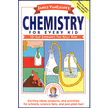The video demonstrating how to make a bottle of dynamic colored diving bubbles.
Dynamic: Something that is dynamic is in perpetual change, or motion, or progressing, etc..
The colored water bubbles form when drops of food coloring are added to a bottle containing oil and water.
Liquid food coloring is a mixture of a colorant (a chemical with a color) and water.
The food coloring is immiscible (not soluble) in the oil and is more dense than the oil.
As the bubbles of food coloring fall through the oil layer, some oil sticks to the outer surface of the bubbles. Thus, the colored bubbles exits the upper oil layer and floats on the surface of the water layer. Stirring or any agitation of the liquids can cause the oil skin of the colored bubble to break, releasing the colored liquid to mix with the water in the bottle.
The pieces of Alkaseltzer are more dense than the oil, thus the pieces sink through the oil and react with the bottom water layer. One if the products of this chemical reaction is a gas called carbon dioxide.
Carbon dioxide is a gas and like other gases have a lower density than do liquids.This results in the carbon dioxide bubbles rising to the surface of the oil and escaping into the air above.
Carbon dioxide is only slightly soluble in water and is not soluble in oil. Thus, most of the carbon dioxide bubbles rise to the surface of the oil and escape into the air above.
As the carbon dioxide bubbles rise to the surface, some cling to the surface of the bubbles of food coloring floating on the surface of the water. These gas bubbles act like tiny life preservers and when enough of them attach, the colored food bubble becomes buoyant (able to float).
The colored bubbles rise to the surface because with the attached gas bubbles, the colored bubble plus the carbon dioxide bubbles has a density less than water or oil.
The colored bubbles fall when the attached carbon dioxide bubbles are knocked off or break when they hit the surface of the oil. Either way, the colored bubbles fall when their density is more than that of oil. They rise again as more gas bubble stick to them.
Some of the bubbles of food coloring combine, thus the blending of these colors form a bigger and different color bubble.

